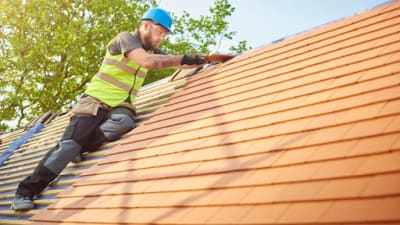Comprehending the Different Kinds of Roofing Systems: A Comprehensive Overview for Homeowners
With an array of alternatives-- ranging from the conventional gable to the contemporary flat-- each type offers one-of-a-kind benefits and difficulties that should straighten with the house owner's details demands and ecological considerations. As we explore the details of various roof covering types, it comes to be noticeable that one size does not fit all; the best selection might surprise you.
Saddleback Roof
Saddleback roofs, defined by their triangular form, are among the most popular roofing designs as a result of their simplicity and efficiency in shedding water and snow. This layout includes two sloping sides that meet at a ridge, enabling reliable water drainage and reducing the danger of water buildup. The high pitch generally linked with saddleback roofs enhances their capability to deal with hefty precipitation, making them appropriate for numerous environments.
In addition to their useful benefits, gable roofing systems offer aesthetic versatility. They can be adjusted to numerous building styles, from typical to modern homes. The style can additionally fit extra attributes such as dormer windows, which boost natural light and air flow in the attic room space.
Moreover, saddleback roofs offer ample space for insulation, contributing to energy effectiveness. Property owners can select from a variety of roof covering materials, including asphalt roof shingles, metal, and ceramic tiles, further improving modification alternatives.
Despite their advantages, gable roofing systems may need additional assistance in locations vulnerable to high winds or hefty snowfall. On the whole, the saddleback roof continues to be a preferred option because of its blend of capability, toughness, and aesthetic appeal.
Flat Roofs
Level roofing systems are commonly acknowledged for their minimalist style and useful applications, especially in industrial and business settings (oahu roofing). These roofs feature a straight or almost horizontal surface area, which enables simple building and construction and functional area use. While they may do not have the visual charm of pitched roofings, level roof coverings supply numerous benefits, particularly in urban settings where maximizing area is important
Among the primary benefits of level roofing systems is their accessibility. Homeowners can make use of the roof area for various functions, such as rooftop gardens, terraces, or solar panel setups. Additionally, level roofs are commonly a lot more affordable to keep and mount contrasted to their sloped equivalents, as they need fewer materials and labor.
However, flat roof coverings do present specific difficulties. Appropriate drain is important to stop water pooling, which can cause leakages and architectural damages. Hence, choosing top notch waterproofing products and regular inspections are crucial for guaranteeing long life. Usual products utilized for flat roofings consist of built-up roof (BUR), customized asphalt, and single-ply membranes, each offering distinct advantages. In general, flat roof coverings serve as a practical and versatile choice for many homeowners and organizations alike.
Hip Roofing Systems
Hip roofings are defined by their sloped sides that assemble on top, creating a ridge. This layout stands out from saddleback roofs, as all four sides of a hip roofing slope downwards towards the wall surfaces, providing a much more secure structure. The angle of the slopes can differ, enabling flexibility in building visual appeals and functionality.
One of the main benefits of hip roofings is their capacity to endure heavy winds and unfavorable climate condition. The sloped surfaces make it possible for much better water drainage, decreasing the risk of leakages and water damages. In addition, hip roofing systems use enhanced attic room space, which can be made use of for storage or also exchanged livable areas.
Nevertheless, creating a hip roofing can be much more complicated and expensive than less complex roofing system types, such as saddleback roofs. The added product and labor associated with developing the inclines and making sure correct structural honesty can result in higher costs. In spite of these disadvantages, several house owners favor hip roof coverings for their toughness, visual charm, and potential for energy efficiency.
Mansard Roof Coverings
Mansard roofings, commonly recognized by their distinct four-sided layout, function two slopes on each side, with the reduced incline being steeper than the upper. This architectural style, stemming from France in the 17th century, is not only aesthetically enticing however practical, as it makes the most of the functional area in the top floorings of a building. The steep lower slope enables for more headroom, making it a suitable option for loft spaces or attic rooms, which can be exchanged living areas.
Mansard roof coverings are characterized by their flexibility, accommodating numerous building designs, from standard to modern-day. They can be created with different products, including asphalt tiles, slate, or steel, giving property owners with a variety of choices to suit their preferences and budget plans. Furthermore, the layout permits the integration of dormer windows, boosting natural light and air flow in the upper degrees.
However, it is important to take into consideration the prospective drawbacks. Mansard roof coverings might require more maintenance as a result of the intricacy of their design, and their high inclines can be testing for snow and rainfall drainage. Overall, mansard roofings combine sophistication with practicality, making them a preferred option among house owners seeking distinctive architectural functions.
Shed Roof Coverings
As home owners increasingly look for simplicity and functionality in their building designs, shed roofing systems have arised as a popular selection. Defined by a single sloping aircraft, a shed roofing system provides a minimalist aesthetic that matches different home styles, from contemporary to rustic.
One of the primary benefits of a shed roofing is its straightforward building, which frequently converts to reduce labor and product costs. This style enables for reliable water drainage, lowering the danger of leaks and water damages. Furthermore, the upright slope provides ample space for skylights, improving all-natural light within the inside.
Dropped roof coverings additionally use convenience in terms of use. They can be successfully incorporated into additions, garages, or outside frameworks like sheds and structures. try this website In addition, this roof covering design can accommodate various roof covering materials, including steel, asphalt shingles, and even environment-friendly roofings, straightening with green efforts.
Nevertheless, it is important to consider regional environment problems, as heavy snow lots may necessitate modifications to the roof covering's click over here now angle or framework. In general, lost roofings present a useful and cosmetically pleasing choice for homeowners aiming to take full advantage of functionality without endangering design.
Conclusion


Gable roofings, characterized by their triangular shape, are have a peek here amongst the most preferred roof covering designs due to their simpleness and performance in shedding water and snow. oahu roofing. The high pitch commonly associated with gable roofing systems improves their capacity to handle hefty rainfall, making them suitable for various environments
While they may do not have the visual charm of pitched roofs, level roof coverings provide various advantages, specifically in metropolitan atmospheres where optimizing room is essential.

 Edward Furlong Then & Now!
Edward Furlong Then & Now! Brian Bonsall Then & Now!
Brian Bonsall Then & Now! Josh Saviano Then & Now!
Josh Saviano Then & Now! Sydney Simpson Then & Now!
Sydney Simpson Then & Now! Jeri Ryan Then & Now!
Jeri Ryan Then & Now!